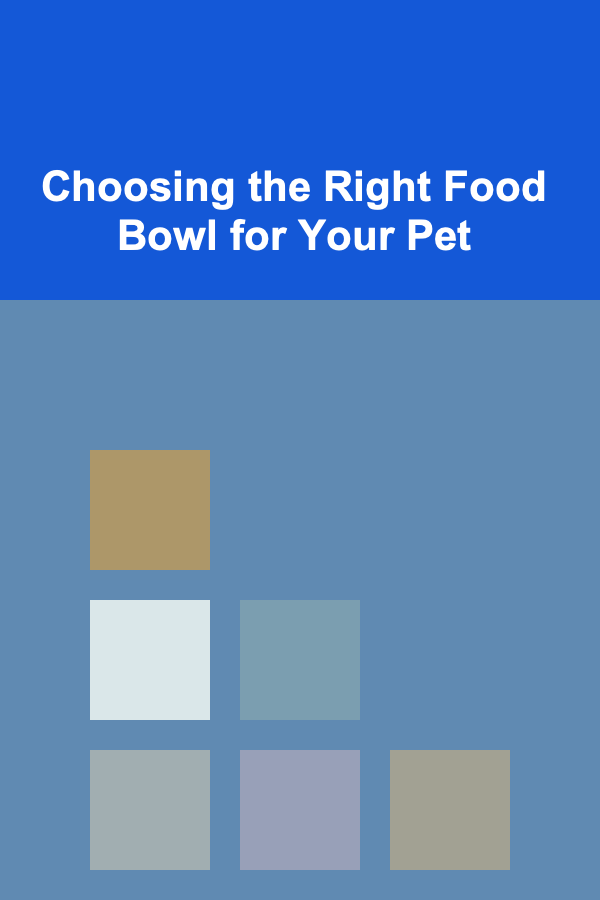
Choosing the Right Food Bowl for Your Pet
ebook include PDF & Audio bundle (Micro Guide)
$12.99$5.99
Limited Time Offer! Order within the next:

Selecting the appropriate food bowl for your beloved pet might seem like a trivial decision, but it's a choice that significantly impacts their health, comfort, and overall well-being. A poorly chosen bowl can contribute to digestive issues, musculoskeletal problems, behavioral changes, and even hygiene concerns. This article delves into the multifaceted considerations involved in selecting the perfect food bowl, encompassing material, shape, size, height, and specific needs related to different breeds and health conditions. By understanding these factors, you can ensure your pet enjoys a safe and comfortable dining experience.
Material Matters: A Deep Dive into Bowl Composition
The material of your pet's food bowl is paramount, affecting not only its durability and hygiene but also potentially impacting your pet's health. Here's a detailed look at the most common materials:
Stainless Steel: The Gold Standard
Stainless steel bowls are often considered the gold standard for several compelling reasons:
- Hygiene: Stainless steel is non-porous, meaning it doesn't harbor bacteria, mold, or odors as easily as other materials. This makes it exceptionally hygienic and easy to clean thoroughly, which is crucial for preventing foodborne illnesses.
- Durability: Stainless steel bowls are incredibly durable and resistant to scratches, dents, and rust. They can withstand years of use and are often dishwasher-safe, further simplifying cleaning.
- Safety: High-quality stainless steel is generally considered safe for pets, as it doesn't leach harmful chemicals into their food or water. Ensure you choose bowls made from food-grade stainless steel (typically 18/8 or 304 grade).
- Neutrality: Stainless steel doesn't impart any taste or odor to the food, which is especially important for picky eaters. Some pets are sensitive to the taste or smell of plastic or ceramic, leading them to avoid their food.
Caveats: While stainless steel is generally excellent, be mindful of the quality. Cheap, low-grade stainless steel might contain trace amounts of harmful metals. Always purchase from reputable brands and verify the material's grade.
Ceramic: Aesthetics vs. Practicality
Ceramic bowls are aesthetically pleasing and come in a variety of designs, making them a popular choice for pet owners who prioritize visual appeal. However, they also present some challenges:
- Hygiene Concerns: Ceramic can be porous, especially if it's not properly glazed. This porosity allows bacteria and odors to penetrate the material, making it difficult to clean thoroughly.
- Chipping and Cracking: Ceramic is prone to chipping and cracking, especially if dropped or exposed to sudden temperature changes. Chipped bowls can harbor bacteria and present a sharp edge that could injure your pet.
- Lead Glaze: Some ceramic bowls, particularly those manufactured outside of regulated markets, may contain lead in the glaze. Lead is toxic to pets and humans, so it's crucial to ensure your ceramic bowl is lead-free and food-safe. Look for bowls certified as food-grade and lead-free.
- Weight: Ceramic bowls are generally heavier than stainless steel or plastic bowls, which can be an advantage if you have a pet that tends to push their bowl around.
Mitigating the Risks: If you choose a ceramic bowl, opt for one with a thick, non-porous glaze and ensure it's certified as food-grade and lead-free. Inspect the bowl regularly for chips or cracks, and replace it immediately if any are found. Hand-washing is often recommended to prolong its life and prevent damage.
Plastic: Convenience with Caveats
Plastic bowls are inexpensive, lightweight, and come in a wide range of colors and designs. However, they are the least hygienic and durable option:
- Hygiene Issues: Plastic is porous and scratches easily, creating microscopic crevices where bacteria can thrive. These scratches are difficult to clean, even with thorough washing.
- Chemical Leaching: Certain types of plastic can leach harmful chemicals, such as BPA (Bisphenol A) and phthalates, into the food or water, particularly when exposed to heat. These chemicals have been linked to various health problems in both animals and humans.
- Durability: Plastic bowls are easily chewed, scratched, and cracked, leading to potential ingestion of plastic fragments.
- Odor Absorption: Plastic absorbs odors over time, which can deter picky eaters.
When to Consider Plastic: While generally not recommended for everyday use, plastic bowls might be suitable for travel or temporary situations where weight and cost are major concerns. If you do choose plastic, opt for BPA-free and phthalate-free options and replace them frequently.
Silicone: A Flexible Alternative
Silicone bowls are a relatively newer option that offers some advantages over plastic, particularly in terms of safety and flexibility:
- Food-Grade and Safe: High-quality silicone is typically food-grade and free of harmful chemicals like BPA and phthalates.
- Flexible and Portable: Silicone bowls are flexible and collapsible, making them ideal for travel or storage.
- Non-Porous (Relatively): While not as non-porous as stainless steel, silicone is less porous than plastic and easier to clean.
- Durable: Silicone is relatively durable and resistant to cracking, although it can be chewed by some pets.
Considerations: Ensure you choose silicone bowls specifically designed for pet food and made from high-quality, food-grade silicone. Check for any signs of damage or chewing regularly.
Shape and Size: Matching the Bowl to Your Pet
The shape and size of the food bowl should be carefully considered to ensure your pet can eat comfortably and efficiently. Factors like breed, facial structure, and eating habits all play a role.
Bowl Size: Proportionality is Key
The size of the bowl should be appropriate for your pet's size and appetite. A bowl that's too small will require frequent refills, while a bowl that's too large might encourage overeating or make it difficult for your pet to reach the food at the bottom.
- Small Breeds (e.g., Chihuahuas, Yorkshire Terriers, Toy Poodles): Opt for bowls with a capacity of 1-2 cups.
- Medium Breeds (e.g., Beagles, Cocker Spaniels, French Bulldogs): Bowls with a capacity of 2-4 cups are generally suitable.
- Large Breeds (e.g., Labrador Retrievers, German Shepherds, Golden Retrievers): Choose bowls with a capacity of 4-8 cups or more.
- Giant Breeds (e.g., Great Danes, Saint Bernards, Irish Wolfhounds): Bowls with a capacity of 8 cups or more might be necessary.
Consideration for Cats: Cats generally require smaller bowls than dogs. A bowl with a capacity of 0.5-1 cup is often sufficient, especially for dry food. For wet food, shallow dishes are often preferred.
Bowl Shape: Tailoring to Facial Structure and Breed
The shape of the bowl can significantly impact your pet's ability to eat comfortably, especially for breeds with specific facial structures.
- Flat-Faced (Brachycephalic) Breeds (e.g., Bulldogs, Pugs, Persian Cats): These breeds often have difficulty eating from deep bowls, as their short snouts make it challenging to reach the food at the bottom. Opt for shallow, wide bowls or specialized "slant-faced" bowls designed to accommodate their facial structure.
- Long-Eared Breeds (e.g., Cocker Spaniels, Basset Hounds): Deep, narrow bowls can help prevent their ears from dragging in the food, reducing the risk of ear infections and messy meals. Alternatively, use "snood" or ear covering when feeding.
- Whiskers and Sensitive Noses: Some cats and dogs have sensitive whiskers or noses and may experience "whisker fatigue" or discomfort if their whiskers constantly brush against the sides of the bowl. Choose wide, shallow bowls to avoid this issue.
- Raised Rims: Bowls with raised rims can help contain food and prevent spills, particularly for messy eaters.
- Slanted Bowls: Slanted bowls can make it easier for pets to reach the food and prevent neck strain, especially for older or arthritic animals.
Height Matters: Elevated Bowls and Their Benefits
Elevated food bowls have become increasingly popular, and for good reason. They can offer several benefits, particularly for certain pets:
Potential Benefits of Elevated Bowls
- Improved Posture: Elevated bowls allow pets to eat without having to bend down as far, which can reduce strain on their neck, back, and joints. This is particularly beneficial for large breeds and older animals with arthritis or other musculoskeletal conditions.
- Reduced Bloat Risk (GDV): While the research is ongoing, some studies suggest that elevated bowls may help reduce the risk of bloat (Gastric Dilatation-Volvulus), a life-threatening condition that affects large, deep-chested dogs. However, other studies suggest the opposite. Consult with your veterinarian for personalized advice.
- Easier Swallowing: Elevating the food bowl can make it easier for pets to swallow, particularly those with megaesophagus (enlarged esophagus) or other swallowing difficulties.
- Reduced Mess: Elevated bowls can help keep the feeding area cleaner, as they may prevent pets from pushing the bowl around or spilling food.
Determining the Right Height
The ideal height for an elevated bowl depends on your pet's size and breed. The goal is to position the bowl so that your pet can eat with their head and neck in a relatively neutral position, without having to bend down excessively or reach up too high.
- Measure your pet's height at the withers (the highest point of their shoulders).
- Subtract 2-6 inches from that measurement to determine the appropriate bowl height. A smaller subtraction is appropriate for taller dogs.
- Observe your pet while they eat. If they are still bending down significantly or appear uncomfortable, you may need to adjust the height of the bowl.
Potential Drawbacks
While elevated bowls offer several benefits, there are also some potential drawbacks to consider:
- Bloat Controversy: As mentioned earlier, the impact of elevated bowls on bloat risk is still debated. Some studies suggest they may actually increase the risk in some breeds. Always discuss this with your veterinarian.
- Cost: Elevated bowls are generally more expensive than standard bowls.
- Stability: Some elevated bowls can be less stable than standard bowls, especially if they are not properly designed or weighted.
Addressing Specific Needs and Conditions
Certain breeds and health conditions may necessitate specialized food bowls to ensure optimal comfort and health.
Slow Feeder Bowls: Curbing Rapid Eating
Rapid eating can lead to several health problems, including bloat, indigestion, and vomiting. Slow feeder bowls are designed to slow down your pet's eating pace by incorporating obstacles or mazes within the bowl.
- How They Work: Slow feeder bowls feature ridges, bumps, or other obstacles that force pets to eat more slowly and deliberately. This helps them feel fuller faster and reduces the risk of overeating.
- Benefits:
- Reduced risk of bloat and indigestion.
- Improved digestion and nutrient absorption.
- Increased satiety and reduced begging.
- Mental stimulation and enrichment.
- Choosing the Right Slow Feeder: There are various types of slow feeder bowls available, ranging from simple designs with a few ridges to more complex mazes. Choose a design that is appropriate for your pet's size, breed, and eating habits. Start with an easier design and graduate to more challenging ones as your pet gets used to it.
Automatic Feeders: Convenience and Portion Control
Automatic feeders dispense food at pre-programmed intervals, providing convenience and helping to control portion sizes. They can be particularly useful for pets with diabetes, weight management issues, or when you are away from home.
- Types of Automatic Feeders:
- Timer-Based Feeders: These feeders use a timer to release food at set times.
- Portion-Controlled Feeders: These feeders dispense a specific amount of food at each feeding.
- Microchip-Controlled Feeders: These feeders only open for pets with a registered microchip, preventing other pets from stealing their food. Useful in multi-pet households where one pet is on a special diet.
- Considerations:
- Ensure the feeder is reliable and dispenses the correct amount of food.
- Choose a feeder that is easy to clean and maintain.
- Monitor your pet's weight and adjust portion sizes as needed.
Water Fountains: Encouraging Hydration
Proper hydration is crucial for pet health, and some pets are reluctant to drink enough water from a standard bowl. Water fountains provide a constant source of fresh, flowing water, which can encourage pets to drink more.
- Benefits:
- Increased water intake.
- Improved kidney health.
- Reduced risk of urinary tract infections.
- Fresh, filtered water.
- Choosing a Water Fountain:
- Choose a fountain made from pet-safe materials, such as stainless steel or BPA-free plastic.
- Ensure the fountain is easy to clean and maintain.
- Look for a fountain with a filter to remove impurities and odors.
Bowls for Special Diets or Medical Conditions
If your pet has specific dietary needs or medical conditions, you may need to consider specialized bowls:
- Allergy-Friendly Bowls: For pets with food allergies, choose bowls made from hypoallergenic materials like stainless steel or ceramic with a lead-free glaze.
- Bowls for Megaesophagus: These bowls are designed to help pets with megaesophagus eat in an upright position, reducing the risk of aspiration. They often come with a stand to elevate the bowl to the correct height.
- Bowls for Pets with Mobility Issues: Choose bowls that are easy to access and don't require your pet to bend down too far. Elevated bowls or bowls with wide, shallow rims can be helpful.
Maintenance and Hygiene: Keeping Your Pet's Bowl Clean
Regular cleaning and maintenance of your pet's food bowl are essential for preventing the growth of bacteria and ensuring your pet's health. Here are some tips:
- Wash the bowl daily with hot, soapy water. Rinse thoroughly to remove all traces of soap.
- Dishwasher-safe bowls can be washed in the dishwasher on the hot cycle.
- Disinfect the bowl regularly with a pet-safe disinfectant.
- Replace the bowl if it becomes damaged or worn.
- For water bowls, change the water at least once a day and clean the bowl regularly. Consider using a water fountain with a filter to keep the water clean and fresh.
Conclusion: Making an Informed Choice for Your Pet's Wellbeing
Choosing the right food bowl for your pet is a more complex decision than it might initially appear. By carefully considering the material, shape, size, height, and your pet's specific needs, you can ensure a comfortable, hygienic, and enjoyable dining experience. Prioritize hygiene by opting for stainless steel whenever possible, and be mindful of any breed-specific considerations or health conditions that may require specialized bowls. Regular cleaning and maintenance are also crucial for maintaining your pet's health and well-being. Ultimately, the best food bowl is one that promotes your pet's health, comfort, and overall happiness.

How to Incorporate Greenery and Plants into Your Home Decor on a Budget
Read More
How to Make Money with AI: Using Deep Learning for Passive Income
Read More
How To Understand Quantum Computing's Role in Drug Discovery
Read More
How to Choose Sustainable Outdoor Gear
Read More
How to Fold Origami Flowers That Look Real
Read More
10 Tips for a Study Schedule Planner That Prioritizes Wellbeing
Read MoreOther Products

How to Incorporate Greenery and Plants into Your Home Decor on a Budget
Read More
How to Make Money with AI: Using Deep Learning for Passive Income
Read More
How To Understand Quantum Computing's Role in Drug Discovery
Read More
How to Choose Sustainable Outdoor Gear
Read More
How to Fold Origami Flowers That Look Real
Read More